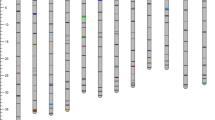Abstract
Clonal replicates of different transformed potato plants expressing transgene constructs containing the constitutive Cauliflower Mosaic Virus (CaMV) 35S promoter, and sequences encoding the plant defensive proteins snowdrop lectin (Galanthus nivalis agglutinin; GNA), and bean chitinase (BCH) were propagated in tissue culture. Plants were grown to maturity, at first under controlled environmental conditions, and later in the glasshouse. For a given transgene product, protein accumulation was found to vary between the different lines of clonal replicates (where each line was derived from a single primary transformant plant), as expected. However, variability was also found to exist within each line of clonal replicates, comparable to the variation of mean expression levels observed between the different clonal lines. Levels of GNA, accumulated in different parts of a transgenic potato plant, also showed variation but to a lesser extent than plant–plant variation in expression. With the majority of the clonal lines investigated, accumulation of the transgene product was found to increase as the potato plant developed, with maximum levels found in mature plants. The variation in accumulation of GNA among transgenic plants within a line of clonal replicates was exploited to demonstrate that the enhanced resistance towards larvae of the tomato moth, Lacanobia oleracea L., caused by expression of this protein in potato, was directly correlated with the level of GNA present in the plants, and that conditions under which the plants were grown affect the levels of GNA expression and subsequent levels of insect resistance.
Similar content being viewed by others
References
Bano Maqbool S and Christou P (1999) Multiple traits of agronomic importance in transgenic indica rice plants; analysis of transgene integration patterns, expression level and stability. Mol Breed 5: 471–480.
Bell HA, Fitches EC, Down RE, Marris GC, Edwards JP, Gatehouse JA and Gatehouse AMR (1999) The effect of snowdrop lectin (GNA) delivered via artificial diet and transgenic plants on Eulophus pennicornis (Hymenoptera: Eulophidae), a parasitoid of the tomato moth Lacanobia oleracea (Lepidoptera: Noctuidae). J Insect Physiol 45: 983–991.
Boller T, Gehri A, Mauch F and Vögeli U (1983) Chitinase in bean leaves: induction by ethylene, purification, properties and possible function. Planta 157: 22–31.
Bown DP, Wilkinson HS and Gatehouse JA (1997) Differentially regulated inhibitor-sensitive and insensitive protease genes from the phytophagous insect pest, Helicoverpa armigera, are members of complex multigene families. Insect Biochem Mol Biol 27: 625–638.
Bradford MM (1976) A rapid and sensitive method for the quantification of microgram quantities of protein using the principle of protein-dye binding. Anal Bioch 72: 248–254.
Broglie KE, Gaynor JJ and Broglie RM (1986) Ethylene-regulated gene expression. Molecular cloning of the genes encoding an endochitinase from Phaseolus vulgaris. Proc Natl Acad Sci USA 83: 6820–6824.
Davies HV (1996) Recent developments in our knowledge of potato transgenic biology. Potato Res 39: 411–427.
De Carvalho F, Gheysen G, Kushnir S, Van Montagu M, Inze D and Castresana C (1992) Suppression of beta-1,3-glucanase transgene expression in homozygous plants. EMBO J 11: 2595–2602.
Fitches E, Gatehouse AMR and Gatehouse JA (1997) Effects of snowdrop lectin (GNA) delivered via artificial diet and transgenic plants on the development of tomato moth (Lacanobia oleracea) larvae in laboratory and glasshouse trials. J Insect Physiol 43: 727–739.
Gatehouse AMR, Davison GM, Newell CA, Merryweather A, Hamilton WDO, Burgess EPJ, Gilbert RJC and Gatehouse JA (1997) Transgenic potato plants with enhanced resistance to the tomato moth, Lacanobia oleracea: growth room trials. Mol Breed 3: 49–63.
Hart CM, Fischer B, Neuhaus J-M and Meins F (1992) Regulated inactivation of homologous gene expression in transgenic Nicotiana sylvestris plants containing a defense-related tobacco chitinase gene. Mol Genet 235: 178–188.
Koncz C, Martini N, Mayerhof R, Koncz-Kalman Z, Körber H, Redei GP and Schell J (1989) High-frequency T-DNA-mediated gene tagging in plants. Proc Natl Acad Sci USA 86: 8467–8471.
Linn F, Heidmann I, Saedler H and Meyer P (1990) Epigenetic changes in the expression of the maize A1 gene in Petunia hybrida: role of numbers of integrated gene copies and state of methylation. Mol Gen Genet 222: 329–336.
Meins FJ (1989) Habituation: heritable variation in the requirement of cultured plant cells for hormones. Ann Rev Genet 23: 395–408.
Meyer P (1995) Variation of transgene expression in plants. Euphytica 85: 359–366.
Neumann K, Dröge-Laser W, Köhne S and Broer I (1997) Heat treatment results in a loss of transgene-encoded activities in several tobacco lines. Plant Physiol 115: 939–947.
Newell CA, Rozman R, Hinchee MA, Lawson EC, Haley L, Sanders P, Kaniewski W, Tumer NE, Horsch RB and Fraley RT (1991) Agrobacterium-mediated transformation of Solanum tuberosum L. cv. Russet Burbank. Plant Cell Rep 10: 30–34.
Pang SZ, Jan FJ, Carney K, Stout J, Tricoli DM, Quemada HD and Gonsalves D (1996) Post-transcriptional transgene silencing and consequent tospovirus resistance in transgenic lettuce are affected by transgene dosage and plant development. Plant J 9: 899–909.
Peach C and Velten J (1991) Transgene expression variability (position effect) of CAT and GUS reporter genes driven by linked divergent T-DNA promoters. Plant Mol Biol 7: 49–60.
Renckens S, De Greve H, Van Montagu M and Hernalsteens J-P (1992) Petunia plants escape from negative selection against a transgene by silencing the foreign DNA via methylation. Mol Gen Genet 233: 53–64.
Van Damme EJM (1991) Analysis of cDNA clones from Amaryllidaceae and Alliaceae species. Ph.D thesis, Katholieke Universiteit Leuven.
Walter C, Broer I, Hillemann D and Pühler A (1992) High frequency, heat treatment-induced inactivation of the phosphothricin resistance gene in transgenic single cell suspension cultures of Medicago sativa. Mol Gen Genet 235: 189–196.
Author information
Authors and Affiliations
Rights and permissions
About this article
Cite this article
Down, R.E., Ford, L., Bedford, S.J. et al. Influence of plant development and environment on transgene expression in potato and consequences for insect resistance. Transgenic Res 10, 223–236 (2001). https://doi.org/10.1023/A:1016612912999
Issue Date:
DOI: https://doi.org/10.1023/A:1016612912999




